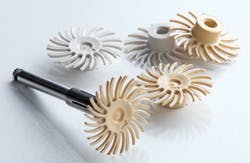Pearls for your practice
by Joe Blaes, DDS
Sof-Lex™ Spiral Finishing and Polishing Wheels
from 3M ESPE.
These wheels are a new way to put the final natural-looking gloss on restorations. With an innovative spiral shape that adapts to tooth surfaces, Sof-Lex dental finishing and polishing wheels give dentists a versatile and simple alternative to traditional points, cups, discs, and brushes. I have been using 3M's contouring and polishing discs for longer than I care to remember to polish materials that I do not even remember the names of. The primary goal of finishing is to create a restoration that has good contour, occlusion, healthyVisit www.3mespe.com/soflex for more information.
Ceraresin Bond Porcelain & Resin Repair System
from Shofu Dental.
Picture an emergency patient who has come into the office with a "broken tooth." Your assistant seats the patient, and the patientVisit www.shofu.com or call (800) 827-4638 for more information.
Honigum Rigid X-tra Fast & Honigum Mono QuadFast
from DMG America.
These are the latest additions to the line of Honigum outcome-enhancing impression materials. In my opinion, Dr. Joe Massad is the preeminent instructor of denture prosthetics. He has developed and teaches techniques that have simplified the placement of dentures. His research has made the process easier for dentists around the world. The real winners in all of this are the patients, who end up with superior fitting and functioning dentures. Dr. Massad contacted DMG America to help him develop an impression material
that would complement his techniques. Dr. Massad has created a unique thermoplastic impression tray that can be heated and adjusted to exactly fit the patient's arch form. He was looking for an impression material that would take the perfect edentulous impression without any distortions. DMG America has produced Honigum Rigid X-tra Fast to meet Dr. Massad's specifications. This is a thixotropic impression material that will stay where you put it. Thus, it will only move under load. The first step is to create stops for accurate reseating of the tray. The locations on the maxillary tray are the distal ends of the tray, anterior, and palatal arch. The locations on the mandibular tray are the distal ends of the tray and the anterior segment. Apply a thin layer of tray adhesive to the tray and its borders. To border mold, simply apply Honigum Rigid X-tra Fast into the tray and onto its borders. Replace the tray into the mouth no later than 1 minute and 15 seconds after the start of mixing in the correct position indicated by the stops. Then have the patient go through the series of functional movements. Here is a tip: The material sets faster in the mouth than on the bench. It is advisable to insert the tray as quickly as possible to allow enough time for the functional movements before the material is set. Please remember this X-tra Fast material. Remove the tray earliest 1 minute and 30 seconds after insertion. Check and mark up any areas where the tray's borders are exposed. Cut away excess material with a scalpel or silicone bur. Trim down exposed areas with the bur and reapply tray adhesive. Apply suitable correction material to the tray/impression and follow the molding steps given above. If there are parts of the tray that are missing material, especially in the palate, use Honigum Mono QuadFast to fill in these areas. This material is a faster-setting version of Honigum Mono. Get these materials and follow these techniques, and you will get amazing edentulous impressions and patients will love their dentures. Another tip: Honigum Mono QuadFast is also a new, faster, and highly accurate material for single-unit crown-and-bridge impressions. Dr. Massad has one of the best and most beautifully decorated combinations of a dental office, learning center, and video production center that I have ever seen. You will be amazed at how many things he can teach you about dentistry. Located in Tulsa, Okla., he can be reached at [email protected] .
Visit www.dmg-america.com for more information on this great new impression material that has been developed for a specific technique for better dentistry for patients.
To have Dr. Joe Blaes present his lecture, "Pearls For Your Practice®," for your study group or dental society, please call (866) 274-4500.
Past DE Issues



